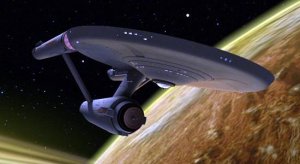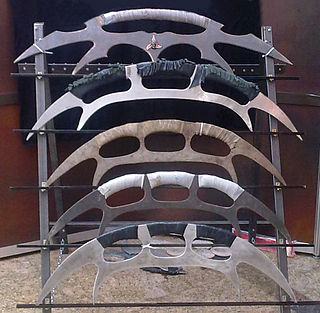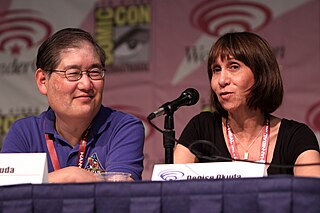Related Research Articles

Star Trek Generations is a 1994 American science fiction film and the seventh film in the Star Trek film series. Malcolm McDowell joins cast members from the 1960s television show Star Trek and the 1987 spin-off The Next Generation, including William Shatner and Patrick Stewart. In the film, Captain Jean-Luc Picard of the USS Enterprise-D joins forces with Captain James T. Kirk to stop the villain Tolian Soran from destroying a planetary system in his attempt to return to an extra-dimensional realm known as the Nexus.
Star Trek: Voyager is an American science fiction television series created by Rick Berman, Michael Piller, and Jeri Taylor. It originally aired from January 1995 to May 2001 on UPN, lasting for 172 episodes over seven seasons. The fifth series in the Star Trek franchise, it served as the fourth sequel to Star Trek: The Original Series. Set in the 24th century, when Earth is part of a United Federation of Planets, it follows the adventures of the Starfleet vessel USS Voyager as it attempts to return home after being stranded in the Delta Quadrant on the far side of the Milky Way galaxy.

Enterprise or USS Enterprise is the name of several fictional spacecraft, some of which are the main craft and setting for various television series and films in the Star Trek science fiction franchise. The most notable were Captain James T. Kirk's USS Enterprise (NCC-1701) from the original 1960s television series, and Captain Jean-Luc Picard's USS Enterprise (NCC-1701-D) from Star Trek: The Next Generation.

The bat'leth is a double-sided scimitar/hook sword/deer horn knives hybrid-edged weapon with a curved blade, four points, and three handholds on the back. It was designed and created by Star Trek: The Next Generation visual effects producer Dan Curry for the Star Trek franchise, where it is the characteristic melee weapon of Klingons. Curry has called the bat'leth "one of the iconic images associated with the show." It has spawned a smaller version, which became known as the "mek'leth"; in Klingon, this is written meqleH. Bat'leths have become an enduring symbol of the franchise among fans, and they are occasionally referenced in other media.

Brannon Braga is an American television producer, director and screenwriter. Best known for his work in the Star Trek franchise, Braga was a key creative force behind three of the franchise's live action series. He later became an executive producer and writer on several Fox shows including 24, Terra Nova, and The Orville. His film credits include Mission: Impossible 2, Star Trek Generations and Star Trek: First Contact.
The Star Trek canon is the set of all canonical material in the Star Trek universe. The official Star Trek website defines canon as comprising the television series and feature films of the franchise.

Michael Okuda is an American graphic designer best known for his work on Star Trek.
Richard Michael Sternbach is an illustrator who is best known for his space illustrations and his work on the Star Trek television series.
Daniel Curry is a visual effects producer and supervisor, as well as a main title designer in the film and television industry.

"Trials and Tribble-ations" is the 104th episode of the American science fiction television series Star Trek: Deep Space Nine, the sixth episode of the fifth season. It was written as a tribute to the original series of Star Trek, in the 30th anniversary year of the show; sister series Voyager produced a similar episode, "Flashback". The idea for the episode was suggested by René Echevarria, and Ronald D. Moore suggested the link to "The Trouble with Tribbles". The two were credited for their work on the teleplay, with the story credit going to Ira Steven Behr, Hans Beimler, and Robert Hewitt Wolfe.
Foundation Imaging was a CGI visual effects studio, computer animation studio, and post-production editing facility founded by Paul Beigle-Bryant and Ron Thornton that pioneered digital imaging for television programming using Newtek's LightWave 3D, originally on Commodore Amiga based Video Toaster workstations.
Peter Lauritson is a long-time film producer and director and television producer and director who first became involved with the Star Trek franchise with Star Trek II: The Wrath of Khan. He went on to become a producer for Star Trek: The Next Generation, and supervising producer for Deep Space Nine, Voyager and Enterprise. He directed three episodes of those series, including the Hugo Award-winning "The Inner Light", as well as being second unit director for two Star Trek films.

Denise Lynn Okuda is a computer, scenic and video supervisor, and a writer known for her work on several Star Trek film and television productions, as well as other science fiction television. She also co-authored the Star Trek Encyclopedia and the Star Trek Chronology.
David Livingston is an American television producer and director. He is mostly known for his involvement in the writing and production of the various modern Star Trek franchises.
Bruce Branit is an American filmmaker with a strong background in Computer graphics and visual effects. He has received eight Emmy Award nominations for his work on shows such as Westworld, Breaking Bad and Star Trek: Voyager. He is the owner of Branit FX based in Kansas City which provides visual effects work for feature television, film and commercials. His production company Lucamax Pictures is currently developing several long and short form entertainment projects.

Doug Drexler is a visual effects artist, designer, sculptor, illustrator, and a makeup artist who has collaborated with such talents as Al Pacino, Dustin Hoffman, James Caan, Meryl Streep, and Warren Beatty. He began his career in the entertainment industry working for makeup artist Dick Smith on such films as The Hunger and Starman. He has also contributed to Three Men and a Little Lady, The Cotton Club, FX, Manhunter and Dick Tracy. Dick Tracy earned Drexler an Oscar, as well as The British Academy Award and the Saturn Award for his special makeup effects on characters such as Big Boy Caprice and Mumbles. Two Emmy nominations in the same field followed for three years working on Star Trek: The Next Generation, where he performed such tasks as aging Captain Picard for "The Inner Light". His final make-up job for the series was the Mark Twain makeup worn by Jerry Hardin in the two part episode "Times Arrow"
The Star Trek franchise features many spacecraft. Various space vessels make up the primary settings of the Star Trek television series, films, and expanded universe; others help advance the franchise's stories. Throughout the franchise's production, spacecraft have been depicted by numerous physical and computer-generated models. Producers worked to balance often tight budgets with the need to depict convincing, futuristic vessels.
Robert Legato is an American visual effects supervisor, second unit director, and second unit director of photography.
Gary Dean Hutzel was an American visual effects supervisor from Ann Arbor, Michigan who worked on the television series Star Trek: The Next Generation, Star Trek: Deep Space Nine, and Battlestar Galactica, among others. He was nominated more than 20 times for Emmy Awards, winning on four occasions.
Armen V. Kevorkian is an American-Armenian visual effects supervisor and television director.
References
- 1 2 3 4 5 "Moore, Ronald B." StarTrek.com. Retrieved June 26, 2016.
- 1 2 "INTERVIEW: Emmy Winning VFX Artist Ronald B. Moore, Pt. 1". StarTrek.com. September 30, 2014. Retrieved June 26, 2016.
- ↑ Michael Okuda [@MikeOkuda] (22 June 2014). "@B1LLY_M0RR15 @RonDMoore VFX supervisor Ronald B. Moore started using his middle initial in the show's credits to avoid confusion with RDM" (Tweet) – via Twitter.
- 1 2 3 4 "INTERVIEW: Emmy Winning VFX Artist Ronald B. Moore, Pt. 2". StarTrek.com. October 1, 2014. Retrieved June 26, 2016.
- ↑ "Ronald B. Moore". Emmys. Retrieved June 26, 2016.